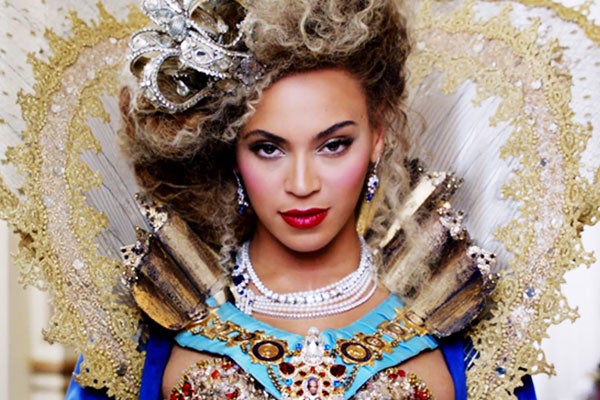Edward Bond ‘The Third Crisis: Drama and Civilization ’
“The first Elizabethan age ended with the discovery of brave new worlds (and incidentally the joining up of the United Kingdom). We are certainly on the edge of vast new unprecedented worlds, cosmic changes in culture, economy and society (and ironically the possible dissolution of the United Kingdom). But are our new worlds brave, cowardly, explorative or degenerative? It could be said the old Elizabethans plundered the new worlds. Perhaps now we can only plunder ourselves and call it trade."
In response to the above quote, I researched some public figures that I feel represent the idea of a New Elizabethan age through their fashion, hair and make-up styling.
 |
| http://www.refinery29.com/2013/02/42663/beyonce-mrs-carter-tour-dates-2013 |
Beyoncé's recent The Mrs Carter Show World Tour is a perfect example of a new Elizabethan fashion. The styling that she used to portray herself was a very contemporary idea of an Elizabethan themed look. Her paler than usual skin tone and rouged lips and cheeks replicate the iconic idea of an Elizabethan make-up and her hair is also done in an up style, which was also a classic look during the Elizabethan era. Beyoncé's high neck collar is a modern interpretation of the Elizabethan fashion, as they always had big ruffs and collars surrounding their necks. Overall, I think that Beyoncé's look here can be easily defined as a new Elizabethan, with the fact that she has taken some of the most iconic make-up and fashion styling from the era and used them to portray herself as 'Queen of the World' to advertise her tour. The colours that Beyoncé has chosen to wear are those that would have been worn by the higher class civilians of society, portraying again the idea that she is a powerful woman.
Beyoncé is also a New Elizabethan in the fact that a lot of teens and women around the world look up to her as a style icon. This is similar to how many women of the Elizabethan era looked up to Queen Elizabeth for style inspiration when making themselves up.
Beyoncé is also a New Elizabethan in the fact that a lot of teens and women around the world look up to her as a style icon. This is similar to how many women of the Elizabethan era looked up to Queen Elizabeth for style inspiration when making themselves up.
 |
| http://anjuthreads.com/eb-kate-middleton/ |
 |
| http://ioet.com/index.php?/plugin/tag/books |
Other examples of a new Elizabethan age within fashion, hair and make-up can be found through contemporary make-up and fashion styling images. The above are both great examples as they replicate and use the classic pale face and darker lip look. In the second image, the idea is taken further here with the styling of the big ruff on the dress. Both styles have again considered the colours that they have used and what they would have represented in the original Elizabethan era.














